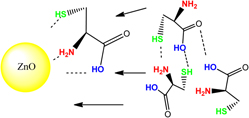Crossref Citations
This article has been cited by the following publications. This list is generated based on data provided by
Crossref.
Arslan, O.
Belkoura, L.
and
Mathur, S.
2015.
Swift synthesis, functionalization and phase-transfer studies of ultrastable, visible light emitting oleate@ZnO quantum dots.
Journal of Materials Chemistry C,
Vol. 3,
Issue. 45,
p.
11965.
Sandmann, Alice
Kompch, Alexander
Mackert, Viktor
Liebscher, Christian H.
and
Winterer, Markus
2015.
Interaction of l-Cysteine with ZnO: Structure, Surface Chemistry, and Optical Properties.
Langmuir,
Vol. 31,
Issue. 21,
p.
5701.
Arslan, Osman
and
Uyar, Tamer
2017.
Multifunctional electrospun polymeric nanofibrous mats for catalytic reduction, photocatalysis and sensing.
Nanoscale,
Vol. 9,
Issue. 27,
p.
9606.
Arslan, Osman
Topuz, Fuat
Eren, Hamit
Biyikli, Necmi
and
Uyar, Tamer
2017.
Pd nanocube decoration onto flexible nanofibrous mats of core–shell polymer–ZnO nanofibers for visible light photocatalysis.
New Journal of Chemistry,
Vol. 41,
Issue. 10,
p.
4145.
Arslan, Osman
Aytac, Zeynep
and
Uyar, Tamer
2017.
Fluorescent Si QD decoration onto a flexible polymeric electrospun nanofibrous mat for the colorimetric sensing of TNT.
Journal of Materials Chemistry C,
Vol. 5,
Issue. 7,
p.
1816.
Wawrzyńczyk, Dominika
Cichy, Bartłomiej
Stęk, Wiesław
and
Nyk, Marcin
2018.
The role of l-cysteine and introduced surface defects in reactive oxygen species generation by ZnO nanoparticles.
Dalton Transactions,
Vol. 47,
Issue. 25,
p.
8320.
Chakraborty, Amlan
Boer, Jennifer C.
Selomulya, Cordelia
and
Plebanski, Magdalena
2018.
Amino Acid Functionalized Inorganic Nanoparticles as Cutting-Edge Therapeutic and Diagnostic Agents.
Bioconjugate Chemistry,
Vol. 29,
Issue. 3,
p.
657.
Mahmoud, Mohamed E.
Hassan, Saad S.M.
Kamel, Ayman H.
and
Elserw, Mahmoud I.A.
2018.
Fast microwave-assisted sorption of heavy metals on the surface of nanosilica-functionalized-glycine and reduced glutathione.
Bioresource Technology,
Vol. 264,
Issue. ,
p.
228.
Aguş, Osman
Abalı, Yüksel
Arslan, Osman
and
Keskin, Nalan Oya San
2019.
Facile and controlled production of silver borate nanoparticles.
SN Applied Sciences,
Vol. 1,
Issue. 7,
Medeiros Borsagli, Fernanda G.L.
de Souza, Ana Júlia M.
and
Paiva, Aislan E.
2020.
Ecofriendly multifunctional thiolated carboxymethyl chitosan-based 3D scaffolds with luminescent properties for skin repair and theragnostic of tissue regeneration.
International Journal of Biological Macromolecules,
Vol. 165,
Issue. ,
p.
3051.
Phatake, Vishal V.
Ahire, Jayendra P.
and
Bhanage, Bhalchandra M.
2020.
L-Serine@ZnO as an efficient and reusable catalyst for synthesis of cyclic carbonates and formamides in presence of CO2 atmosphere.
Molecular Catalysis,
Vol. 492,
Issue. ,
p.
111000.
Thounaojam, Thorny Chanu
Meetei, Thounaojam Thomas
Devi, Yumnam Bijilaxmi
Panda, Sanjib Kumar
and
Upadhyaya, Hrishikesh
2021.
Zinc oxide nanoparticles (ZnO-NPs): a promising nanoparticle in renovating plant science.
Acta Physiologiae Plantarum,
Vol. 43,
Issue. 10,
Yang, Yue
Zou, Tong
Zhao, Rongjun
Kong, Yulin
Su, Linfeng
Ma, Dian
Xiao, Xuechun
and
Wang, Yude
2021.
Fluorescence ‘turn-on’ probe for Al3+ detection in water based on ZnS/ZnO quantum dots with excellent selectivity and stability.
Nanotechnology,
Vol. 32,
Issue. 37,
p.
375001.
Lakshmi, Kunhikrishnan
and
Revathi, Shanmugham
2021.
Rice-Like ZnO Architecture: An Eminent Electrode Material for High-Performance Ultracapacitor Application.
Journal of Inorganic and Organometallic Polymers and Materials,
Vol. 31,
Issue. 5,
p.
1992.
Aguş, Osman
Arslan, Osman
and
Abalı, Yüksel
2021.
Metal borate nanostructures for industrial antibacterial ceramic fabrication.
Inorganic and Nano-Metal Chemistry,
Vol. 51,
Issue. 6,
p.
839.
Medeiros Borsagli, Fernanda G.L.
Rodrigues, Jordane S.
Aguiar, Rafaella A.
Paiva, Aislan Esmeraldo
Vasquez, Jhonattan Frank Baez
Ramos, Welyson Tiano do Santos
Allibrandini, Paulo
Rocha, Elém Patrícia Alves
Gonçalves, Max P.
and
de Souza, Fidel Edson
2022.
Low-cost luminescent scaffolds-based on thiol chitosans by microwave radiation for vertebral disc repair/theragnostic.
International Journal of Biological Macromolecules,
Vol. 209,
Issue. ,
p.
2109.
Kalimuthu, Raja
Meenachi Sellan, Kumuthan
Antony, Dhivya
Rajaprakasam, Sudhagar
Chokkalingam, Vanniarajan
Chidambaram, Prabu
and
Kanagarajan, Selvaraju
2023.
Nanopriming Action of Microwave-Assisted Biofunctionalized ZnO Nanoparticles to Enhance the Growth under Moisture Stress in Vigna radiata.
ACS Omega,
Vol. 8,
Issue. 31,
p.
28143.
Saman, Filiz
Al, Ebru
Boylu, Bilge
and
Arslan, Osman
2023.
Chemically modified starch with silicon quantum dots: Structures and properties.
Journal of Carbohydrate Chemistry,
Vol. 42,
Issue. 4-6,
p.
158.
Runjhun, Rashmi
Alharbi, Essa A.
Drużyński, Zygmunt
Krishna, Anurag
Wolska‐Pietkiewicz, Małgorzata
Škorjanc, Viktor
Baumeler, Thomas P.
Kakavelakis, George
Eickemeyer, Felix
Mensi, Mounir
Zakeeruddin, Shaik M.
Graetzel, Michael
and
Lewiński, Janusz
2024.
High‐Performance Perovskite Solar Cells with Zwitterion‐Capped‐ZnO Quantum Dots as Electron Transport Layer and NH4X (X = F, Cl, Br) Assisted Interfacial Engineering.
ENERGY & ENVIRONMENTAL MATERIALS,
Vol. 7,
Issue. 5,
San José, Leire
Yuriychuk, Nastasiya
García, Olga
López-González, Mar
and
Quijada-Garrido, Isabel
2024.
Exploring Functional Polymers in the Synthesis of Luminescent ZnO Quantum Dots for the Detection of Cr6+, Fe2+, and Cu2+.
Polymers,
Vol. 16,
Issue. 3,
p.
429.



